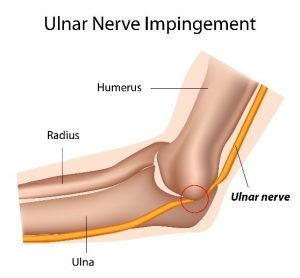Reflex sympathetic dystrophy (RSD), or complex regional pain syndrome, is a serious condition that can cause severe pain and significant disability. (See Wikipedia)
I was asked to visit an 83 year old woman at her home who had suffered from this condition for more than a year, to check her blood pressure and to ensure there were no negative effects from her medications. While there, for no apparent reason she developed pain, tingling, and was unable to move the fingers on her right hand. Due to unresponsive anti-inflammatory medications and pain-killers, her orthopedic surgeon recommended surgery to relieve pressure over the ulnar nerve at the elbow - the nerve that supplied the forearm and hand - better known as the "funny bone". (The red circle in the picture.) The operation was intended to relieve pressure on the nerve and ease her pain, but unfortunately, the nerve was damaged, causing severe pain, darkening of the skin and paralysis of her forearm and hand. Unable to bend her elbow or drive her car, she was confined to her home.
She was suffering from a condition called “reflex sympathetic dystrophy”.

On my first visit, her right hand had been unusable and agonisingly painful for 12 months. Finger movement was impossible, and poor blood circulation caused the skin on the whole of her hand and forearm to be deep blue in colour and icy cold. No physical treatment or medication had helped ease her pain.
I let her know that a week earlier the wheatgrass extract had successfully restored the blood supply of a 2 year old child whose hands and feet had suddenly gone cold and blue due to Raynaud's disease (a blood circulation condition). On her approval, I applied a small amount of wheatgrass extract to just one cold hand. Almost immediately, her blood circulation recovered to both hands and feet.
After asking me to try and recover her arm, I squeezed a little wheatgrass extract cream on to a toothpick and very carefully applied it in a thin line, along her forearm and hand. To my amazement, a thin, blanched line formed instantaneously then began to slowly widen. After a couple more minutes the entire dark-coloured area had turned white - then pink and warm, clearly demonstrating the return of blood supply to the pale area.
Then, after about another three minutes, both her hands had turned warm and pink, confirming that neurotransmission had crossed the spinal cord, thereby increasing blood circulation. A few minutes later, she had regained full sensation in her hand and the shooting pains that made her life such a misery had gone. She could now also move her "paralysed" fingers for the first time in a year.
Follow up
On calling on her two days later, she was upset because her pain was only relieved for two or three hours, then returned. She was therefore reluctant to try the cream again on her arm. But, she did agree to me applying the wheatgrass cream over her elbow, near the ulnar nerve. To my amazement, this immediately relieved the pain of her forearm and hand and enabled extension of her left elbow's range of movement. Clearly, the extract had restored blood circulation and nerve transmission in both her arm and hand.
The extract had clearly reconnected damaged peripheral sensory nerves to the brain, and restored blood circulation and muscular movement to the area.
Although the patient refused further wheatgrass extract "treatment", there were many complex physiological wheatgrass extract functions "normalising" dysfunctional areas. Please go to this link for a more detailed and up to date explanation.